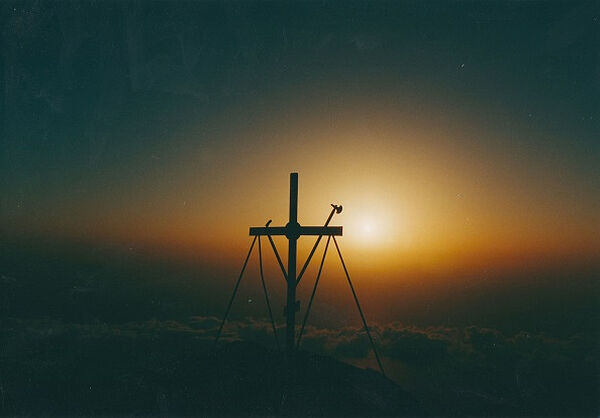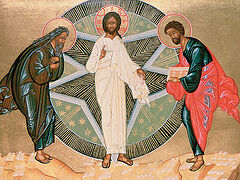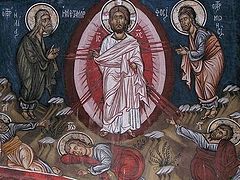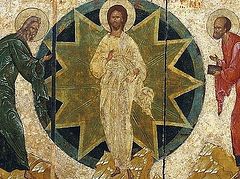For centuries now, on the eve of the Transfiguration, a host of monks leave the Great Lavra with animals laden with provisions, vestments, and sacred vessels, and they climb to the peak of Mt. Athos, at a height of one and a quarter miles, above the clouds, where there is the small chapel of the Transfiguration of the Lord. On the evening of the following day, they’ll serve the All-Night Vigil there according to the typikon, similar to the typikons of other monasteries of the Holy Mountain. Gradually ascending the mountain, as the Apostles once did an high mountain (Mt. 17:1), they sing pre-festal hymns to the rhythm of bells jingling on the mules: “Come, let us go with Jesus, ascending the Holy Mount.”
Pilgrims of various nationalities also join them along the way from other parts of Athos. The resulting procession is reminiscent of the Jews gathering from all corners of Palestine with the proselytes, to celebrate in the house of the Lord on Zion (2 Chron. 30:25), whither the tribes go up, the tribes of the LORD, unto the testimony of Israel, to give thanks unto the name of the LORD (Ps. 121:4).
This “holy summit,” often covered with the purest snow, now reflecting the rays of the sun, now shrouded in clouds, was destined to become a “Mountain of Light,” as the ancient word aithon means “fiery, radiant, aglow.” This peak holds a special place in the heart of Athonites. They see in it the axis of the earth, connecting Heaven and earth; a pillar from which prayers arise to God; a kind of footstool of the throne of God; the chosen dwelling of the Queen of All, the “Mother of Light.”
Countless icons and frescoes depict the Theotokos in the heavens on the snow-covered tip of Mt. Athos, covering the world with her maphorion, the “holy veil” of her prayers.
Moreover, according to an immutable ancient tradition, monks come here from time to time to pray nearer to Heaven and receive an answer from God at important moments in their lives.
It was here in the tenth century, on the day of the Transfiguration, that the abbot of Iveron Monastery, St. Euthymius the Athonite, beheld the Divine Light shining like a burning fire as he was serving the Liturgy: “Suddenly the brightest light shone everywhere, and the earth shook. All prostrated themselves, and only Blessed Euthymius stood, like a pillar of fire, remaining motionless before the holy altar.”
Four centuries later, the Theotokos appeared to St. Maximus of Kavskokalyvia, surrounded by a bright light and sweet fragrance, holding the Lord in her arms, Who blessed St. Maximus and filled him with holy jubilation. Centuries later, on the same spot where this mysterious miracle took place, Elder Joseph (†1959), a great hesychast and true father of the modern rebirth of the tradition of noetic prayer on the Holy Mountain, met his companion the Elder Arsenios (†1983) and began a strict ascetic life and wandering along the slopes of the Holy Mountain. One day, when he was beset by despondency, a brilliant ray of light shone from this very peak and entered his heart. And from that very day, as if on Mt. Tabor, his mind and heart ever abode in Jesus.
There’s a tradition that seven ascetics live on this peak, naked and unknown to anyone, preserving for centuries and transmitting the mystical tradition of asceticism and contemplation from generation to generation.
Whether this tradition is true or not, it shows how important a place the “Holy Summit” holds in the consciousness and life of Athonite monks. Therefore, the little Transfiguration Chapel and the tall metal cross next to it, which stand on this narrow rock, possess a special symbolism and point to Heaven and earth as two characteristic components of the monastic life: the experience of the Cross, the voluntary and unceasing participation in the Passion of the Lord, and at the same time a path to theosis and life in the light of the eschatological glory that Christ once revealed to the Apostles on Mt. Tabor. As the Lord ascended the mountain with His chosen Disciples in order to pray (Lk. 9:28), so the monks, having renounced the world, live on Mt. Athos in silence and prayer, living here and now in the light of the Transfiguration. Athos is for them a Tabor, a foretaste of the Kingdom of Heaven.
At the decline of the Byzantine Empire, when St. Gregory Palamas, an Athonite monk and great teacher of the Divine Light, was fighting against humanists, defending the hesychasts, and supporting the Orthodox teaching on the deification of man—his real participation in the life of God through uncreated grace—the theme of the Transfiguration and the nature of the Taboric light was at the center of attention. In all their works, St. Gregory Palamas and his supporters make innumerable references to this holy event and show that the Transfiguration of the Lord, as an image of our personal deification, is the feast par excellence of monasticism; the feast of the Holy Mountain. St. Gregory lived many years at the base of Mt. Athos in the Great Lavra, in the Cell of St. Savvas, located high in the mountains. Therefore, for every modern Athonite, Mt. Athos is identified with Mt. Tabor and with every “mountain of the Lord,” where the Lord revealed Himself to man. For them, it’s Mt. Zion, Mt. Carmel, the Mount of Olives, and Golgotha. Athos is also similar to other “holy mountains” for them, where the Lord has settled in His sanctuary (Ps. 150:1), in the assembly of gods (Ps. 81:1). In particular: Mt. Olympus and Mt. Bithynia, where the first Athonites came from, Mt. Latros, Mt. Ganos, Mt. St. Auxentius and other glorious monastic centers of Asia Minor, and holy mountains of Greece. Furthermore, you can draw a parallel with Mt. Olympus—the ancient abode of the twelve gods. Athos is also akin to the holy rock formations of Meteora, on the highest of which is the Monastery of the Transfiguration, the mountains of the Peloponnese, Macedonia, the Carpathian region, Serbia, Armenia with its great Ararat, the Caucasus Mountains, and the mountains of Russia, including the little “holy mountain” of St. Seraphim in the Sarov forest, Monte Cassino of St. Benedict, Mt. Mercurion—the stronghold of Byzantine ascetics in Calabria, and all the other holy mountains of the Orthodox West. Thus, Athos is equated with all the mountains, like Tabor, for the monastics living there in all times.
That night, in a tiny chapel where only a few people can fit, while the rest try to warm themselves by a large fire burning outside, the voices of the chanters turn into trumpets of the Church, proclaiming the message of Eternal Light to the world.
An excerpt from Transfiguration, Akritas Publications, pp. 121-125




